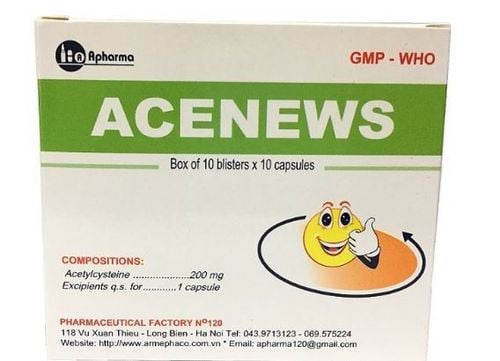This is an automatically translated article.
Acitys drug has the main active ingredient is Acetylcysteine with a content of 200mg and other excipients in sufficient quantity. Acitys belongs to the group of drugs that act on the gastrointestinal tract. The drug is used in the treatment of respiratory secretion disorders such as bronchial asthma, sinusitis, ...
1. What is Acitys?
Acitys medicine has the main active ingredient is Acetylcysteine with a concentration of 200mg and other excipients in sufficient quantity. The drug Acitys belongs to the group of drugs that act on the gastrointestinal tract. The dosage form of the drug is powdered form, suitable for direct oral use.
1.1. Pharmacodynamics of the drug Acitys Main active ingredient Acetylcysteine is a mucolytic agent in a mucolytic manner. Acitys acts on the gel phase of mucus by cleavage of disulfur bridges of glycoproteins.
Acitys reduces the viscosity of sputum in purulent or non-purulent lungs by cleaving the disulfide bridges in mucoproteins and facilitating expulsion of sputum by coughing, postural drainage, or other mechanical means. The main active ingredient Acetylcysteine is also used topically for tear-free treatment. Acetylcysteine is used to protect against hepatotoxicity from paracetamol overdose, by maintaining or restoring hepatic glutathione levels, which are required for the intermediate metabolism of highly toxic paracetamol. liver.
1.2. Pharmacokinetics of the drug Acitys After oral administration, the main active ingredient, Acetylcysteine, is rapidly absorbed from the gastrointestinal tract and is reduced by the liver from acetyl to cysteine and then metabolized. Acitys reaches peak plasma concentrations approximately 0.5 to 1 hour after oral doses of 200 to 600 mg. Oral bioavailability is low and may be due to metabolism in the intestinal wall and first-pass metabolism in the liver.
Renal clearance may account for 30% of systemic clearance. After intravenous administration, the mean terminal half-life was 1.95 and 5.58 hours, respectively, for reduced acetylcysteine and total acetylcysteine; After oral administration, the terminal half-life of total Acetylcysteine is 6.25 hours.
2. What disease does Acitys treat?
Acitys drug is effective in the treatment of bronchial and sinus respiratory secretion disorders, especially in acute bronchial diseases such as:
Acute bronchitis; Acute phase of chronic bronchopulmonary disease.
3. Usage and dosage of Acitys
Acitys drug is prepared in powder form, suitable for direct oral use.
How to make medicine: Dissolve 1 sachet in 50-100ml of water and should be taken before main meals.
For children from 2 to 7 years old:
One sachet, 2 times a day. For adults and children over 7 years old:
One sachet, 3 times a day. Duration of treatment:
Do not use more than 8 to 10 days without special instructions from the treating doctor. An overdose of drugs containing the active ingredient Acetylcysteine has symptoms similar to those of anaphylaxis, but much more severe, especially a decrease in blood pressure. Other symptomatic signs include respiratory failure, hemolysis, disseminated intravascular coagulation, and renal failure. The risk of life-threatening even death has occurred in people who have overdosed with Acetylcysteine while being treated for intoxication with the active ingredient Paracetamol. Treatment of drug overdose depends on the accompanying symptoms.
4. Undesirable effects of the drug Acitys
Acetylcysteine has a relatively wide safety margin. Some undesirable effects may be encountered when using Acitys, including:
Common undesirable effects such as nausea, vomiting. Undesirable effects are less common such as: Drowsiness, headache, tinnitus; stomatitis, runny nose; rash, urticaria. Rare adverse effects include: bronchospasm with anaphylactoid reactions to the body; fever accompanied by chills. Instructions on how to handle unwanted effects:
When using a solution containing diluted Acetylcysteine, it can reduce the possibility of causing vomiting due to drug use.
5. Drug interactions of Acitys
The combination of mucus-modifying drugs specifically Acitys and antitussives and/or expectorants (atropin-like effects) can cause drug interactions.
6. Some notes when using Acitys
Do not use Acitys in the following cases:
People with a history of allergic asthma (risk of bronchospasm reactions with all forms of Acetylcysteine). People with sensitive or hypersensitivity to the active ingredient Acetylcysteine. Notes when using Acitys:
Must closely monitor patients at risk of asthma attack, if using Acitys for people with a history of allergies. For those with bronchospasm, a bronchodilator nebulizer such as Salbutamol (a short-acting selective beta-2 adrenergic drug) or Ipratropium (an anti-Muscarin drug) must be used and treatment with drugs containing this active ingredient must be discontinued. Acetylcysteine immediately. When treating with drugs containing the active ingredient Acetylcysteine, specifically Acitys, there may be a lot of thin sputum in the bronchi, which needs to be aspirated to remove if you reduce the ability to cough. The article has provided information about Acitys drug effects, dosage and notes when using. To ensure safety for your health and maximize the effectiveness of your treatment, you need to take Acitys exactly as directed by your doctor.
Please dial HOTLINE for more information or register for an appointment HERE. Download MyVinmec app to make appointments faster and to manage your bookings easily.













